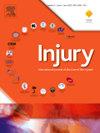Infectious complications after traumatic spine injury requiring surgery in a French level-1 trauma center: An observational study
IF 2.2
3区 医学
Q3 CRITICAL CARE MEDICINE
Injury-International Journal of the Care of the Injured
Pub Date : 2025-03-30
DOI:10.1016/j.injury.2025.112305
引用次数: 0
Abstract
Background
Traumatic spine injury (TSI) is a prevalent condition that often requires surgical intervention. Two serious infectious complications after surgery are surgical site infections (SSI) and lower respiratory tract infections (LRTI). Yet, studies on SSI and LRTI on trauma patients, particularly with a specific focus on microbiology are lacking. The primary aim of this study is to investigate the prevalence rate of early SSI, occurring within one month of surgery or three months when instrumented, and LRTI in level-1 trauma center patients requiring surgery after TSI.
Methods
This monocenter retrospective observational study was conducted at an academic level-1 trauma center, including patients with TSI requiring surgery. Data on patients’ baseline characteristics, trauma related information, initial and intra-operative management, infectious complications data and hospitalization outcomes were collected. The two primary outcomes were the prevalence of early SSI and LRTI. Secondary outcomes included the identification of factors associated with developing these infections, analysis of identified organisms, and assessment of clinical outcomes.
Results
A total of 2606 patients were screened between May 2018 and October 2022, 194 were included. Most of them were polytrauma patients defined by Injury Severity Score ≥ 16 (71 %). Early SSI occurred in 20 patients (10 %) and LRTI occurred in 58 patients (30 %). The number of vertebral levels instrumented (odds ratio [OR] 1.24, 95 % confidence interval [95 % CI] 1.01–1.52) was associated with SSI. The causative organisms were predominantly Gram-positive cocci (19/36 identified organisms). Factors associated with LRTI were an injury severity score ≥ 25 (OR 7.41; 95 % CI, 3.28–17.99), spinal injury at levels C3-C7 (OR 2.24; 95 % CI 1.01–5.14) and antibiotics during initial management (OR 7.09; 95 % CI, 2.71–20.49). The causative organisms were predominantly Gram-negative bacilli (58/80 identified organisms). Patients with LRTI experienced longer hospital stays, extended durations of mechanical ventilation, and higher mortality rates at 30 days and one year than those without.
Conclusion
Early SSI and LRTI are underestimated complications in severe trauma patients with TSI requiring surgery. Identifying risk factors and causative organisms is an important step for advancing research on targeted prevention and treatment of SSI and LRTI after trauma.
求助全文
约1分钟内获得全文
求助全文
来源期刊
CiteScore
4.00
自引率
8.00%
发文量
699
审稿时长
96 days
期刊介绍:
Injury was founded in 1969 and is an international journal dealing with all aspects of trauma care and accident surgery. Our primary aim is to facilitate the exchange of ideas, techniques and information among all members of the trauma team.

 求助内容:
求助内容: 应助结果提醒方式:
应助结果提醒方式:


